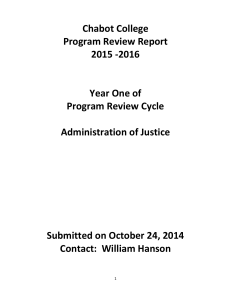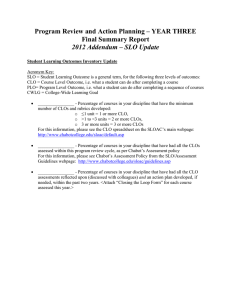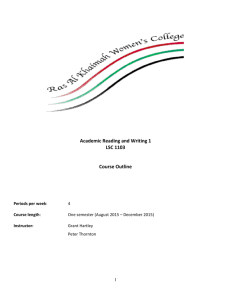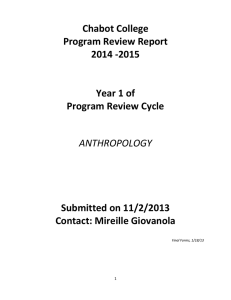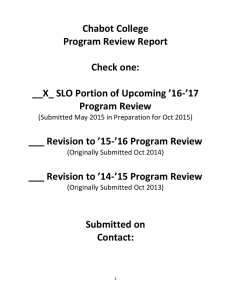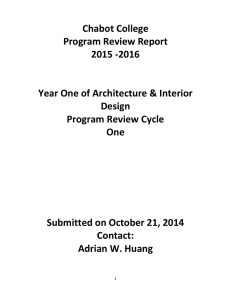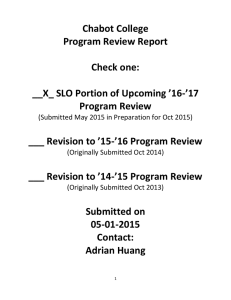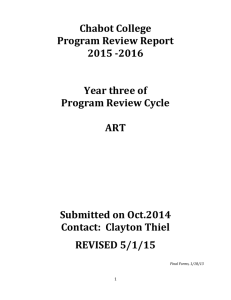Chabot College Program Review Report 2014 ‐2015
advertisement
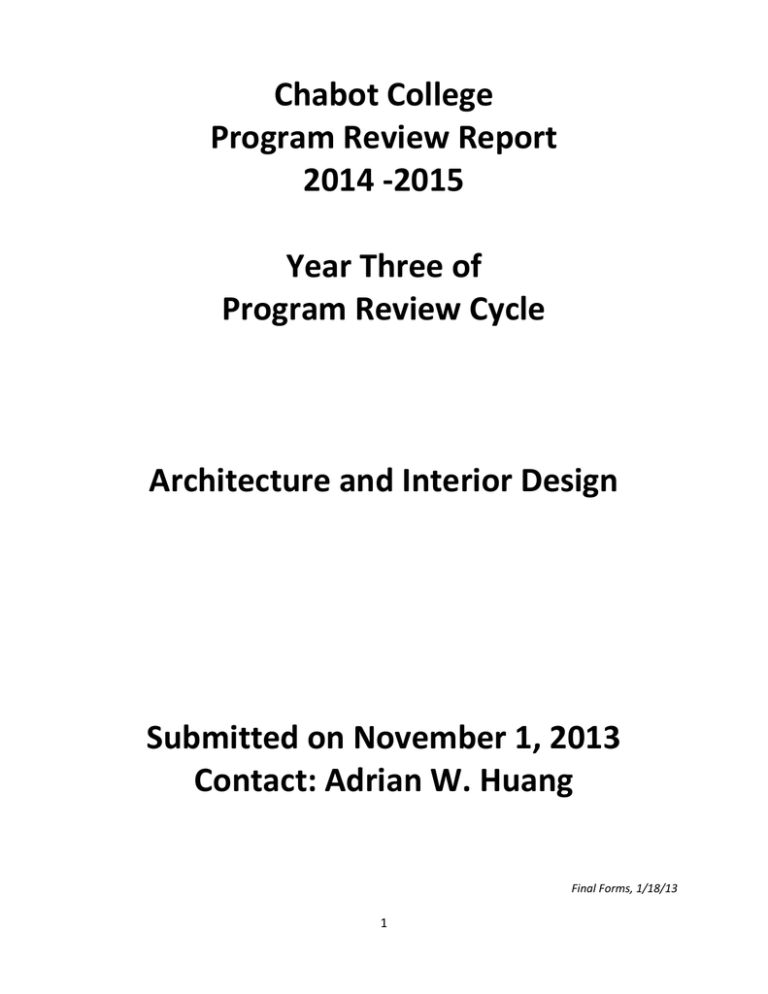
Chabot College Program Review Report 2014 ‐2015 Year Three of Program Review Cycle Architecture and Interior Design Submitted on November 1, 2013 Contact: Adrian W. Huang Final Forms, 1/18/13 1 Appendix B2: “Closing the Loop” Assessment Reflections Course Semester assessment data gathered Number of sections offered in the semester Number of sections assessed Percentage of sections assessed Semester held “Closing the Loop” discussion Faculty members involved in “Closing the Loop” discussion ARCH 2A Spring 2012 1 1 100% Fall 2012 Paul Chu, Adrian Huang Form Instructions: Part I: CLO Data Reporting. For each CLO, obtain Class Achievement data in aggregate for all sections assessed in eLumen. Part II: CLO Reflections. Based on student success reported in Part I, reflect on the individual CLO. Part III: Course Reflection. In reviewing all the CLOs and your findings, reflect on the course as a whole. PART I: COURSE‐LEVEL OUTCOMES – DATA RESULTS Defined Target Scores* (CLO Goal) CONSIDER THE COURSE‐LEVEL OUTCOMES INDIVIDUALLY (THE NUMBER OF CLOS WILL DIFFER BY COURSE) (CLO) 1: Actual Scores** (eLumen data) 75% 75% 75% 75% 80% 75% DEVELOP ARCHITECTURAL AND FREEHAND DRAWING SKILLS. (CLO) 2: DESIGN AND COMMUNICATE SOLUTIONS TO INTRODUCTORY ENVIRONMENTAL DESIGN PROBLEMS THROUGH A VARIETY OF MEDIA FOR PRESENTATION. (CLO) 3: IDENTIFY ARCHITECTURAL DRAWING SYSTEMS AND APPLY METHODOLOGY TO PRODUCE ORTHOGRAPHIC, PARALINE OBLIQUE, AND PERSPECTIVE DRAWINGS. (CLO) 4: If more CLOs are listed for the course, add another row to the table. * Defined Target Scores: What scores in eLumen from your students would indicate success for this CLO? (Example: 75% of the class scored either 3 or 4) **Actual scores: What is the actual percent of students that meet defined target based on the eLumen data collected in this assessment cycle? 2 PART II: COURSE‐ LEVEL OUTCOME REFLECTIONS A. COURSE‐LEVEL OUTCOME (CLO) 1: 1. How do your current scores match with your above target for student success in this course level outcome? It met the expectation. 2. Reflection: Based on the data gathered, and considering your teaching experiences and your discussions with other faculty, what reflections and insights do you have? Improve pre‐requisite preparation and provide drafting board set‐up in studio as means to do work as intended. Time commitment for more practice is key to improved outcome. B. COURSE‐LEVEL OUTCOME (CLO) 2: 1. How do your current scores match with your above target for student success in this course level outcome? Very good. 2. Reflection: Based on the data gathered, and considering your teaching experiences and your discussions with other faculty, what reflections and insights do you have? Improve students’ awareness to assess workload for commitment to timely completion of project deliverables as critical success factor. 3 C. COURSE‐LEVEL OUTCOME (CLO) 3: 1. How do your current scores match with your above target for student success in this course level outcome? Very good. 2. Reflection: Based on the data gathered, and considering your teaching experiences and your discussions with other faculty, what reflections and insights do you have? Basic drafting skills and knowledge of the drawing system conventions serve as a universal language in communicating technical design drawing. Course Semester assessment data gathered Number of sections offered in the semester Number of sections assessed Percentage of sections assessed Semester held “Closing the Loop” discussion Faculty members involved in “Closing the Loop” discussion ID 68 Spring 2012 1 1 100% Fall 2012 Barbara Daher, Adrian Huang Form Instructions: Part I: CLO Data Reporting. For each CLO, obtain Class Achievement data in aggregate for all sections assessed in eLumen. Part II: CLO Reflections. Based on student success reported in Part I, reflect on the individual CLO. Part III: Course Reflection. In reviewing all the CLOs and your findings, reflect on the course as a whole. PART I: COURSE‐LEVEL OUTCOMES – DATA RESULTS CONSIDER THE COURSE‐LEVEL OUTCOMES INDIVIDUALLY (THE NUMBER OF CLOS WILL DIFFER BY COURSE) (CLO) 1: IDENTIFY HARDWARE USES AND LIMITATIONS APPROPRIATE TO COMPUTER‐AIDED DESIGN DRAFTING (CADD). 4 Actual Scores** (eLumen data) Defined Target Scores* (CLO Goal) 75% 75% CONSTRUCT DRAWINGS USING AUTOCAD SOFTWARE AND 75% JUSTIFY EXTERNAL REFERENCE FILES AND IMAGES TO DRAWINGS. (CLO) 2: (CLO) 3: FOCUS ON AIA (AMERICAN INSTITUTE OF ARCHITECTS) STANDARD LAYER SYSTEM 75% 80% 85% (CLO) 4: SELECT APPROPRIATE SCALE IN MULTIPLE VIEWS AND PLOTS 75% 85% If more CLOs are listed for the course, add another row to the table. * Defined Target Scores: What scores in eLumen from your students would indicate success for this CLO? (Example: 75% of the class scored either 3 or 4) **Actual scores: What is the actual percent of students that meet defined target based on the eLumen data collected in this assessment cycle? PART II: COURSE‐ LEVEL OUTCOME REFLECTIONS C. COURSE‐LEVEL OUTCOME (CLO) 1: 3. How do your current scores match with your above target for student success in this course level outcome? Good 4. Reflection: Based on the data gathered, and considering your teaching experiences and your discussions with other faculty, what reflections and insights do you have? Students should have basic drafting skills and relate to CAD. D. COURSE‐LEVEL OUTCOME (CLO) 2: 3. How do your current scores match with your above target for student success in this course level outcome? Very good. 5 4. Reflection: Based on the data gathered, and considering your teaching experiences and your discussions with other faculty, what reflections and insights do you have? More practices make it successfully. C. COURSE‐LEVEL OUTCOME (CLO) 3: 3. How do your current scores match with your above target for student success in this course level outcome? Very good. 4. Reflection: Based on the data gathered, and considering your teaching experiences and your discussions with other faculty, what reflections and insights do you have? Students should use industrial drafting standards as well as AIA standards. D. COURSE‐LEVEL OUTCOME (CLO) 4: 1. How do your current scores match with your above target for student success in this course level outcome? Very good. 2. Reflection: Based on the data gathered, and considering your teaching experiences and your discussions with other faculty, what reflections and insights do you have? Students should always apply scales to plans. 6 PART III: COURSE REFLECTIONS AND FUTURE PLANS 1. What changes were made to your course based on the previous assessment cycle, the prior Closing the Loop reflections and other faculty discussions? Our faculties agreed to open more lab/studio hours to students during other related class labs. By this agreement, it will make computer lab and studio hours more flexible and available to students. 2. Based on the current assessment and reflections, what course‐level and programmatic strengths have the assessment reflections revealed? What actions has your discipline determined might be taken as a result of your reflections, discussions, and insights? We have requested learning assistants in class lecture and lab hours. Students appreciated the extra helps from learning assistants and extended lab hours. This action has reflected on the reduction in dropping class and in increasing grades. 3. What is the nature of the planned actions (please check all that apply)? Curricular Pedagogical Resource based Change to CLO or rubric Change to assessment methods Other:_____Keep the same ____________________________________________________________ 7 Appendix C: Program Learning Outcomes Considering your feedback, findings, and/or information that has arisen from the course level discussions, please reflect on each of your Program Level Outcomes. Program: ______AA in Architecture __________________________________________ PLO #1: Develop architectural and freehand skills PLO #2: Identify and explain the behavior appearance and use building materials PLO #3: Incorporate the basic Uniform Building Code requirements to construction drawings PLO #4: Describe and apply knowledge of the structural systems using wood, steel, masonry, and concrete What questions or investigations arose as a result of these reflections or discussions? Explain: How much do students know about architecture career/major before enter the program? What program‐level strengths have the assessment reflections revealed? Strengths revealed: Architecture faculties are willing to take on more tasks to help students’ successes. What actions has your discipline determined might be taken to enhance the learning of students completing your program? Actions planned: Plan on having more seminars, field/firm tours, university visits and one on one counseling. Program: _____AS in Architecture___________________________________________ PLO #1: Develop computer drafting skills PLO #2: Develop advanced presentation skills PLO #3: Apply the basic Uniform Building Code requirements to residential and commercial drawings 8 PLO #4: Use wood, truss, steel, masonry, and concrete to apply to structural systems What questions or investigations arose as a result of these reflections or discussions? Explain: How much do students know about architecture career/major before enter the program? What program‐level strengths have the assessment reflections revealed? Strengths revealed: Architecture faculties are willing to take on more tasks to help students’ successes. What actions has your discipline determined might be taken to enhance the learning of students completing your program? Actions planned: Plan on having more seminars, field/firm tours, university visits and one on one counseling. Program: ______AS in Interior Design __________________________________________ PLO #1: Develop functional interior spaces. PLO #2: Draw appropriate floor plans. PLO #3: Demonstrates an understanding of professional practices. What questions or investigations arose as a result of these reflections or discussions? Explain: How to enhance basic drafting skills and computer‐aided design drafting? What program‐level strengths have the assessment reflections revealed? Strengths revealed: Re‐arranged classes sequences to flow students better. What actions has your discipline determined might be taken to enhance the learning of students completing your program? Actions planned: Need more FTEF and Hire more adjunct instructors to offer classes in new two year class sequences. 9
